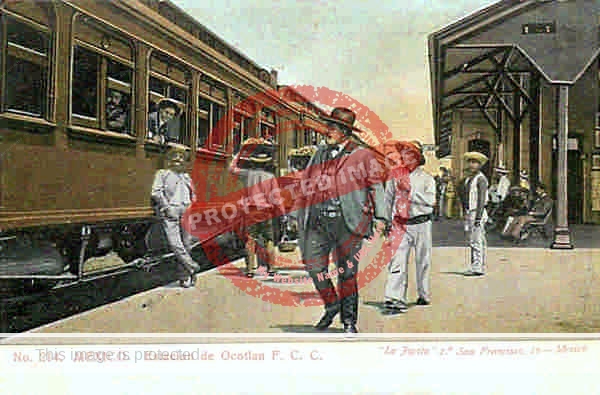Several popular curio shops in downtown Mexico City at the start of the twentieth century stocked all manner of wares to sell to tourists and travelers, and some even published their own postcards of Mexico.
An 1898 list in The Mexican Herald of stores selling “Opals and Mexican Curiosities” included Granat & Horwitz (in the San Carlos Hotel); La Joyita (owned by F. Pardal & Co., and located very close to the Iturbide Hotel); La Compaciente; Sonora News Company; and The Art & Curio Co. Stores founded slightly later include the Iturbide Curio Store (in the basement of the Hotel Iturbide), Jacob Granat; Casa Miret; W. G. Walz Co; and American Stamps Works.
La Joyita started life in about 1898 at 1a de San Francisco #16 before moving to larger premises along the street at 1ra de San Francisco #13-14. In addition to postcards, it sold opals, drawn work, silver filigree, plus “ancient French and Spanish fans and silk shawls.”
La Joyita published at least two series of postcards. The earlier series, dating from around 1904-1905, is comprised of more than 50 black and white cards. The second series, believed to include around 230 cards, is in color and thought to date from around 1906. The relatively poor quality of both series suggests that they were printed locally.
Of local interest, in addition to at least half a dozen cards of Guadalajara, is this interesting card showing the Ocotlán Railroad Station in about 1905.

Photographer unknown (Scott?). Ocotlán Railroad Station, c. 1905. Published by La Joyita.
Ocotlán was one of the main stations on the Mexican Central Railway’s branch line from Irapuato to Guadalajara. This branch line, completed in 1888, reduced the travel time between Mexico City and Guadalajara to under a day, and passengers could finally travel between Mexico’s two largest cities in relative comfort. On this new line, Ocotlán was the nearest station to Lake Chapala; visitors could disembark in Ocotlán and then take the steamboat that made regular trips to several ports on the lake, including Chapala. Many tourists preferred this way of reaching Chapala, since it obviated the need for any bumpy, rickety and sometimes dangerous stagecoach ride. Ocotlán Station became a major transit point for visitors to Lake Chapala’s new hotels.
Ocotlán Station is an important part of the region’s cultural heritage; sadly, part of the historic station was severely damaged by fire in early February 2024.
La Joyita published photographs taken by some of the most distinguished photographers of the time, including Charles Betts Waite, Winfield Scott, La Rochester, Guillermo Kahlo and R J Carmichael. While we can’t be 100% sure of who took the picture of the Ocotlán Railroad Station, it may have well have been American photographer Winfield Scott, who lived close to Ocotlán at the time, and often undertook commissions for the Mexican Central Railway.
His first visit to Ocotlán station left a vivid and lasting impression on Mexican author José Ruben Romero. In 1897, when he was about seven years of age, his family crossed the lake by steamer from La Palma to catch the train in Ocotlán for Mexico City. Romero later wrote about his experience:
The train that I thought was a precious toy turned out to be something heavy and ugly, full of smoke, with an intolerable odor…. I had no alternative but to entertain myself with the movement about the station: well-dressed travelers from Guadalajara who strolled in the sun; others buying jugs of plum wine, fresh cheeses, or fruits. Groups of farmers arrived, the men with valises of striped chintz on their shoulders and full baskets in their hands; the women dressed in brightly colored percales, with squeaky new shoes that caused them to walk as if on thorns.”
My 2022 book Lake Chapala: A Postcard History uses reproductions of more than 150 vintage postcards to tell the incredible story of how Lake Chapala became an international tourist and retirement center.
Note: This post was first published 11 August 2023.
Sources
- The Mexican Herald: 5 Oct 1898, 3; 13 Nov 1898, 11.
- L. Eaton Smith. 1903. The Massey-Gilbert blue book of Mexico for 1903. Mexico City, Mexico : Massey-Gilbert Co.
- Ricardo Pelz Marín and Karla Pelz Serrano. 2013. “Las joyas de ‘La Joyita.'” Presentation at 6th. Mexican Congress on Postcards, Museo Francisco Cossío, San Luis Potosí, August 2013.
- José Rubén Romero. 1932. Apuntes de un lugareño, 148. Translated by John Mitchell and Ruth Mitchell de Aguilar as Notes of a Villager: A Mexican Poet’s Youth and Revolution 1988 Kaneohe, Hawaii: Plover Press. Translation quoted by kind permission of Ms. Margo C. Mitchell of Plover Press.
Comments, corrections and additional material are welcome, whether via the comments feature or email.
Tony Burton’s books include “Lake Chapala: A Postcard History” (2022), “Foreign Footprints in Ajijic” (2022), “If Walls Could Talk: Chapala’s historic buildings and their former occupants” (2020), (available in translation as “Si Las Paredes Hablaran”), “Mexican Kaleidoscope” (2016), and “Lake Chapala Through the Ages” (2008).
Great info–I’m always taken without how much more modern 1900-20 or so Mex city was than 1971 Mex city–but was the photographer Winfield Scott and a grandson of Winfred Scott of-i think the 1848 Mexican war? Irony if so–
To the best of my knowledge there is no known family connection between the two (very different) Winfield Scotts. If anyone has evidence to the contrary, please get in touch!